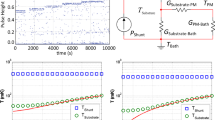Abstract
A new wide-range fast readout system capable of adaptive identification is designed for wire scanners, which are used to measure beam profiles and emittance. This system is capable of handling varying current signals with Gaussian distributions and current pulses up to 1000 counts/s, as well as an input current range of 1 nA–1 mA. When tested, the resolution was found to exceed 3.68% for full scale, the nonlinearity was found to be less than 0.11%, and the measurement sensibility was found to be less than 5 pA. We believe that the system will play a crucial role in improving the measurement accuracy of beam diagnosis and the efficiency of accelerator operation, as well as decreasing the time required for beam tuning. This system was applied to the beam diagnosis of an injector II prototype for an accelerator-driven subcritical system and produced excellent measurement results. A description of the adaptive fast readout system for wire scanners is presented in this paper.






Similar content being viewed by others
References
J. Sun, Y. Ruan, S. Xiao et al., Design of beam profile and halo measurement system for high-intensity RFQ accelerator. High Power Laser Part Beams 23, 190–194 (2011). https://doi.org/10.3788/hplpb20112301.0190. (in Chinese)
U. Hahn, N.V. Bargen, P. Castro et al., Wire scanner system for FLASH at DESY. Nucl. Instrum. Methods A 592, 189–196 (2008). https://doi.org/10.1016/j.nima.2008.04.018
A. La Rosa, M.A. Garella, F. Bourhaleb et al., A pixel ionization chamber used as beam monitor at the Institute Curie-Centre de Protontherapie de Orsay (CPO). Nucl. Instrum. Methods A 565, 833–840 (2006). https://doi.org/10.1016/j.nima.2006.06.024
Y.F. Sui, L. Wang, Y. Zhao et al., BEPCII wire scanner system. Chin. Phys. C 34, 1661–1664 (2010). https://doi.org/10.1088/1674-1137/34/10/021
D. Giovenale, L. Catani, L. Fröhlich, A read-out system for online monitoring of intensity and position of beam losses in electron linacs. Nucl. Instrum. Methods A 665, 33–39 (2011). https://doi.org/10.1016/j.nima.2011.11.038
C.Y. Zhou, H. Su, R.S. Mao et al., An accurate low current measurement circuit for heavy iron beam current monitor. Nucl. Instrum. Methods B 280, 84–87 (2012). https://doi.org/10.1016/j.nimb.2012.01.033
M. Ferrarini, V. Varoli, A. Favalli et al., A wide dynamic range BF3 neutron monitor with front-end electronics based on a logarithmic amplifier. Nucl. Instrum. Methods A 613, 272–276 (2010). https://doi.org/10.1016/j.nima.2009.11.078
C.R. Rose, W. Christensen, Lisa Day et al., SNS Wire Scanner User Guide. Los Alamos National Laboratory, 11 (2002)
Y. Ruan, L. Han, H. Liu et al., Design and simulation of a wire scanner for the CSNS linac. Chin. Phys. C 34, 1655–1660 (2010). https://doi.org/10.1088/1674-1137/34/10/020
Y. Liu, A. Aleksandrov, S. Assadi et al., Laser wire beam profile monitor in the spallation neutron source(SNS) superconducting linac. Nucl. Instrum. Methods A 612, 241–253 (2010). https://doi.org/10.1016/j.nima.2009.10.061
G. Schmidt, U. Hahn, M. Meschkat et al., First results of the high resolution wire scanners for beam profile and absolute beam position measurement at the TTF. Nucl. Instrum. Methods A 475, 545–548 (2001)
T. Yang, S. Fu, T. Xu et al., Thermal analysis for wire scanners in the CSNS Linac. Nucl. Instrum. Methods A 760, 10–18 (2014). https://doi.org/10.1016/j.nima.2014.05.061
A.E. Avetisyan, S.G. Arutunian, I.E. Vasiniuk et al., Yerevan synchrotron injector electron beam transversal scan with vibrating wire scanner. Contemp. Phys. 46, 247–253 (2011). https://doi.org/10.3103/S1068337211060016
Z. Xu, R. Mao, L. Duan et al., A new multi-strip ionization chamber used as online beam monitor for heavy ion therapy. Nucl. Instrum. Methods A 729, 895–899 (2013). https://doi.org/10.1016/j.nima.2013.08.069
F. Yan, Z. Li, J. Tang, Preliminary physics design of China Accelerator Driven Sub-critical System main linac. High Power Laser Part Beams 25, 1783–1787 (2013). https://doi.org/10.3788/hplpb20132507.1783
A. Bosco, M.T. Price, G.A. Blair et al., A two-dimensional laser-wire scanner for electron accelerators. Nucl. Instrum. Methods A 592, 162–170 (2008). https://doi.org/10.1016/j.nima.2008.04.012
Acknowledgements
The authors gratefully acknowledge the staff of the Beam Feedback Department of the Institute of Modern Physics for their assistance in beam testing.
Author information
Authors and Affiliations
Corresponding author
Additional information
This work was supported by the National Natural Science Foundation of China (Nos. 11475233, 11705257, and 11775285).
Rights and permissions
About this article
Cite this article
She, QS., Qian, Y., Kong, J. et al. Design of fast adaptive readout system for wire scanners. NUCL SCI TECH 29, 15 (2018). https://doi.org/10.1007/s41365-017-0343-3
Received:
Revised:
Accepted:
Published:
DOI: https://doi.org/10.1007/s41365-017-0343-3




